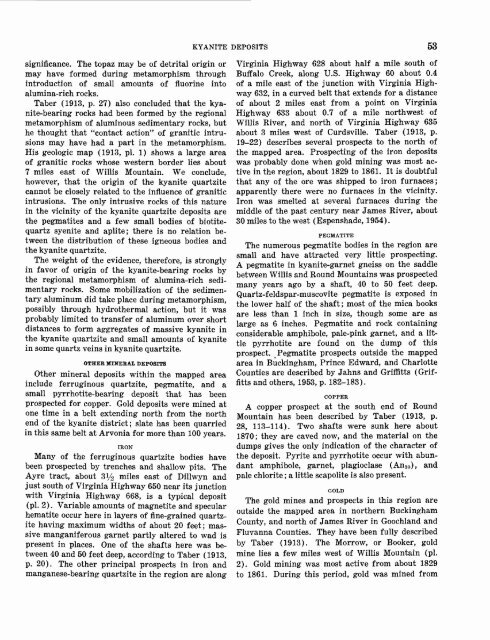Kyanite, Sillimanite, and Andalusite Deposits of the Southeastern ...
Kyanite, Sillimanite, and Andalusite Deposits of the Southeastern ...
Kyanite, Sillimanite, and Andalusite Deposits of the Southeastern ...
Create successful ePaper yourself
Turn your PDF publications into a flip-book with our unique Google optimized e-Paper software.
KYANITE DEPOSITS 53<br />
significance. The topaz may be <strong>of</strong> detrital origin or<br />
may have formed during metamorphism through<br />
introduction <strong>of</strong> small amounts <strong>of</strong> fluorine into<br />
alumina-rich rocks.<br />
Taber (1913, p. 27) also concluded that <strong>the</strong> kyanite-bearing<br />
rocks had been formed by <strong>the</strong> regional<br />
metamorphism <strong>of</strong> aluminous sedimentary rocks, but<br />
he thought that "contact action" <strong>of</strong> granitic intrusions<br />
may have had a part in <strong>the</strong> metamorphism.<br />
His geologic map (1913, pi. 1) shows a large area<br />
<strong>of</strong> granitic rocks whose western border lies about<br />
7 miles east <strong>of</strong> Willis Mountain. We conclude,<br />
however, that <strong>the</strong> origin <strong>of</strong> <strong>the</strong> kyanite quartzite<br />
cannot be closely related to <strong>the</strong> influence <strong>of</strong> granitic<br />
intrusions. The only intrusive rocks <strong>of</strong> this nature<br />
in <strong>the</strong> vicinity <strong>of</strong> <strong>the</strong> kyanite quartzite deposits are<br />
<strong>the</strong> pegmatites <strong>and</strong> a few small bodies <strong>of</strong> biotitequartz<br />
syenite <strong>and</strong> aplite; <strong>the</strong>re is no relation between<br />
<strong>the</strong> distribution <strong>of</strong> <strong>the</strong>se igneous bodies <strong>and</strong><br />
<strong>the</strong> kyanite quartzite.<br />
The weight <strong>of</strong> <strong>the</strong> evidence, <strong>the</strong>refore, is strongly<br />
in favor <strong>of</strong> origin <strong>of</strong> <strong>the</strong> kyanite-bearing rocks by<br />
<strong>the</strong> regional metamorphism <strong>of</strong> alumina-rich sedimentary<br />
rocks. Some mobilization <strong>of</strong> <strong>the</strong> sedimentary<br />
aluminum did take place during metamorphism,<br />
possibly through hydro<strong>the</strong>rmal action, but it was<br />
probably limited to transfer <strong>of</strong> aluminum over short<br />
distances to form aggregates <strong>of</strong> massive kyanite in<br />
<strong>the</strong> kyanite quartzite <strong>and</strong> small amounts <strong>of</strong> kyanite<br />
in some quartz veins in kyanite quartzite.<br />
OTHER MINERAL DEPOSITS<br />
O<strong>the</strong>r mineral deposits within <strong>the</strong> mapped area<br />
include ferruginous quartzite, pegmatite, <strong>and</strong> a<br />
small pyrrhotite-bearing deposit that has been<br />
prospected for copper. Gold deposits were mined at<br />
one time in a belt extending north from <strong>the</strong> north<br />
end <strong>of</strong> <strong>the</strong> kyanite district; slate has been quarried<br />
in this same belt at Arvonia for more than 100 years.<br />
IRON<br />
Many <strong>of</strong> <strong>the</strong> ferruginous quartzite bodies have<br />
been prospected by trenches <strong>and</strong> shallow pits. The<br />
Ayre tract, about 3^ miles east <strong>of</strong> Dillwyn <strong>and</strong><br />
just south <strong>of</strong> Virginia Highway 650 near its junction<br />
with Virginia Highway 668, is a typical deposit<br />
(pi. 2). Variable amounts <strong>of</strong> magnetite <strong>and</strong> specular<br />
hematite occur here in layers <strong>of</strong> fine-grained quartzite<br />
having maximum widths <strong>of</strong> about 20 feet; massive<br />
manganiferous garnet partly altered to wad is<br />
present in places. One <strong>of</strong> <strong>the</strong> shafts here was between<br />
40 <strong>and</strong> 50 feet deep, according to Taber (1913,<br />
p. 20). The o<strong>the</strong>r principal prospects in iron <strong>and</strong><br />
manganese-bearing quartzite in <strong>the</strong> region are along<br />
Virginia Highway 628 about half a mile south <strong>of</strong><br />
Buffalo Creek, along U.S. Highway 60 about 0.4<br />
<strong>of</strong> a mile east <strong>of</strong> <strong>the</strong> junction with Virginia Highway<br />
632, in a curved belt that extends for a distance<br />
<strong>of</strong> about 2 miles east from a point on Virginia<br />
Highway 633 about 0.7 <strong>of</strong> a mile northwest <strong>of</strong><br />
Willis River, <strong>and</strong> north <strong>of</strong> Virginia Highway 635<br />
about 3 miles west <strong>of</strong> Curdsville. Taber (1913, p.<br />
19-22) describes several prospects to <strong>the</strong> north <strong>of</strong><br />
<strong>the</strong> mapped area. Prospecting <strong>of</strong> <strong>the</strong> iron deposits<br />
was probably done when gold mining was most active<br />
in <strong>the</strong> region, about 1829 to 1861. It is doubtful<br />
that any <strong>of</strong> <strong>the</strong> ore was shipped to iron furnaces;<br />
apparently <strong>the</strong>re were no furnaces in <strong>the</strong> vicinity.<br />
Iron was smelted at several furnaces during <strong>the</strong><br />
middle <strong>of</strong> <strong>the</strong> past century near James River, about<br />
30 miles to <strong>the</strong> west (Espenshade, 1954).<br />
PEGMATITE<br />
The numerous pegmatite bodies in <strong>the</strong> region are<br />
small <strong>and</strong> have attracted very little prospecting.<br />
A pegmatite in kyanite-garnet gneiss on <strong>the</strong> saddle<br />
between Willis <strong>and</strong> Round Mountains was prospected<br />
many years ago by a shaft, 40 to 50 feet deep.<br />
Quartz-feldspar-muscovite pegmatite is exposed in<br />
<strong>the</strong> lower half <strong>of</strong> <strong>the</strong> shaft; most <strong>of</strong> <strong>the</strong> mica books<br />
are less than 1 inch in size, though some are as<br />
large as 6 inches. Pegmatite <strong>and</strong> rock containing<br />
considerable amphibole, pale-pink garnet, <strong>and</strong> a little<br />
pyrrhotite are found on <strong>the</strong> dump <strong>of</strong> this<br />
prospect. Pegmatite prospects outside <strong>the</strong> mapped<br />
area in Buckingham, Prince Edward, <strong>and</strong> Charlotte<br />
Counties are described by Jahns <strong>and</strong> Griffitts (Griffitts<br />
<strong>and</strong> o<strong>the</strong>rs, 1953, p. 182-183).<br />
COPPER<br />
A copper prospect at <strong>the</strong> south end <strong>of</strong> Round<br />
Mountain has been described by Taber (1913, p.<br />
28, 113-114). Two shafts were sunk here about<br />
1870; <strong>the</strong>y are caved now, <strong>and</strong> <strong>the</strong> material on <strong>the</strong><br />
dumps gives <strong>the</strong> only indication <strong>of</strong> <strong>the</strong> character <strong>of</strong><br />
<strong>the</strong> deposit. Pyrite <strong>and</strong> pyrrhotite occur with abundant<br />
amphibole, garnet, plagioclase (An30), <strong>and</strong><br />
pale chlorite; a little scapolite is also present.<br />
GOLD<br />
The gold mines <strong>and</strong> prospects in this region are<br />
outside <strong>the</strong> mapped area in nor<strong>the</strong>rn Buckingham<br />
County, <strong>and</strong> north <strong>of</strong> James River in Goochl<strong>and</strong> <strong>and</strong><br />
Fluvanna Counties. They have been fully described<br />
by Taber (1913). The Morrow, or Booker, gold<br />
mine lies a few miles west <strong>of</strong> Willis Mountain (pi.<br />
2). Gold mining was most active from about 1829<br />
to 1861. During this period, gold was mined from
















